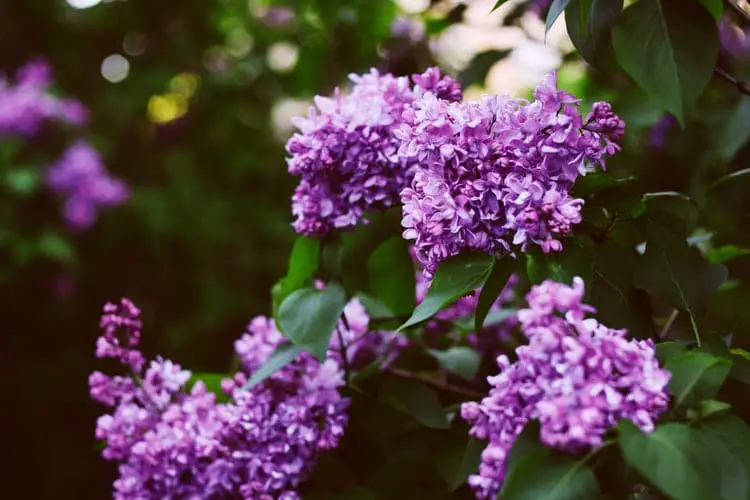
Who doesn’t like lilacs? These scented purple flowers can brighten up the dullest of rooms and bring a smile to any face. Belonging to the orchid family, lilacs usually grow in mountainous regions. If you are fond of lilacs or just getting into gardening and want to try your hand at growing flowering plants – you should read this article till the end. We tell you how you can grow and care for this low-maintenance scented flower.
Why You Should Propagate Lilacs
As we begin to share our tips on how to propagate lilacs, we discuss first why you might have made the right decision in wanting to propagate lilacs.
Propagating lilacs is a wise idea as the life expectancy for this beautiful bloom is only two weeks. There are several ways of propagating lilacs. In this article, we go into how to propagate lilacs from cuttings and suckers.
While learning how to propagate lilacs might still be easy, the procedure can prove difficult if you do not take your cuttings at the right time and provide the cultural conditioning required for rooting.
How to Propagate Lilacs from Cuttings
If you want to propagate lilacs from lilac cuttings, here are the steps you should follow –
- Time your lilac cuttings right. A good time to perform lilac cuttings is early on a spring morning right after flowering. The fresh lilac flower should have ideally attained a height of 4-6 inches.
- Prepare the pots before performing your lilac cuttings to minimize chances of them drying out. Fill peat pots with moist potting soil and sand to accommodate at least 3-4 lilac cuttings, one for each pot. Your lilac cuttings will receive the moisture and stability it needs for the rooting procedure.
- Be careful when choosing the cuttings. Keep your gardening gloves and pruning shears handy. You want to cut 4-6 in softwood lilac cuttings, which contain 2-3 leaf nodes. A softwood cutting refers to that section of a shrub’s stem, which is neither new nor matured. You can make a cutting and then try to break it, to check whether the cutting is softwood or not. If it breaks easily, the cutting is softwood. If not, the wood is either still too young or too old and won’t facilitate rooting. Using sterilized gardening equipment will help diseases from spreading between the plants.
- Take each lilac cutting and dip its end into a rooting hormone-talc mixture. Doing this will promote growth and cell division in your lilac cuttings.
- You want to plant the pots next. Poke an adequately sized hole into each peat pot’s growing medium so it can accommodate the bottom of your lilac cuttings. Insert the cuttings individually and apply water around the base before re-filling the hole with the growing medium. Tamp the medium so that cuttings don’t tip over.
- Use a spray bottle filled with water to mist the area of soil surrounding the cutting. Keep monitoring it closely and repeat this, to keep the cuttings from drying out. Carry this out for 3-6 weeks until the roots of your lilac plants emerge.
- Next, plant the rooted cuttings into peat pots about 3-inches deep. Your peat pots should be placed in an area with ample sunlight and contain composted, moisture-rich soil.
- Remember to water your lilac plant generously. You should provide your lilac cutting with at least 1 inch of water right after planting it. Keep providing it with an inch of water every week or so, unless it rains.
How to Propagate Lilacs from Suckers
In this section, we inform you how to propagate lilacs from suckers. Lilac suckers are essentially shoots that grow around the base of a lilac. Most people like to cut these off the moment they appear, but you can use them to propagate your lilac plants. What steps need to be followed to propagate lilacs from lilac suckers? Read on below.
- Dig up the lilac suckers. Use a hard shovel, shove it down into the ground around the suckers and severe the sucker roots. Keep digging until the lilac sucker pops out of the ground.
- Next, soak them in a bucket full of water. You lessen the shock they experience from being severed by keeping them moist after.
- In order to start potting, you need to fill gallon pots with potting soil halfway and then place your lilac sucker before you fill in the pot with the soil completely. If some of the lilac suckers have large roots, cut them to size before attempting potting. They will fit into your pots better.
- If you wish, you can transplant your lilac suckers directly into the ground as well. There is no need of pots. Use your shovel and dig an appropriately sized hole, place your lilac sucker into this hole and then cover the area with loose soil. Firm this loose soil covering with your foot. Keep watering your newly planted lilac and soon, you will be able to enjoy a sweet-smelling lilac plantation of your own!

Other Ways of Propagating Lilacs at a Glance
- Division – You can cut away the shoots that lilac plants sometimes send up at the root base. Simply cut these off the main plant, while making sure that the roots remain intact, and then grow them as new plants.
- Layering – In this method, a stem from your primary lilac plant is pinned to the soil and secured in place until new roots form from the node. Layering can take some time, but shrubby lilac plants, which contain stems flexible enough to pin down, offer more convenience of use.
- Seeds – If you wish to learn to propagate lilac plants fast, this might not be the method for you. You can propagate a lilac plant from a seed but it is a long-drawn process. It will need months to simply germinate and then, a handful more years, to grow and establish. That said, if you think you have the patience for propagating lilacs in this method, you should try it out. Propagating lilac from lilac seeds can be quite rewarding.
How to Propagate Lilacs Essentials
You will need to keep the following gardening tools and gear ready when you wish to embark on your lilac propagation mission –
- Shovel/spade
- Peat pots
- Sand/vermiculite
- Pruning shears
- Gardening gloves
- Rubbing alcohol
- Clean cloth/paper towel
- Potting mix
- Talc
- Rooting hormone
- Spray bottle
- Watering can
We Wish You All the Best
Lilac propagation is a great way to grow lilacs. We have listed above all the ways in which you can choose to propagate lilac plants. Whether you propagate your lilacs using seeds, shoots or cuttings – we wish you all the very best on your endeavors. Being able to grow these appealing scented flowers can be quite the reward, and we understand why you might want to go about it.
Growing lilacs from scratch is a more complicated procedure, and this is where lilac propagation scores among hobby gardeners. If you know a friend with lilac plants, just ask them to let you borrow a handful of lilac cuttings or buy some shoots from the market. You can get to propagating your lilac plants immediately. Like all beautiful things, lilacs are short-lived and only stay alive for a little over a week. If you wish to derive pleasure from the allure of lilacs in your garden, you might want to equip yourself with knowledge on how to propagate lilacs. We are hopeful we were able to help.
